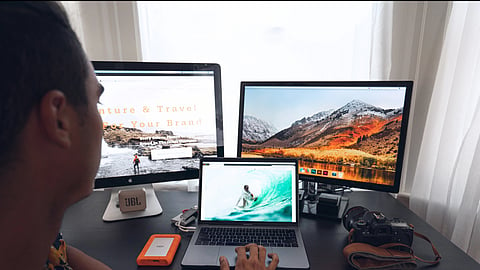

Since the COVID-19 pandemic, the usage of digital devices has been at a greater level. They are part of our daily lives that we can't avoid. We look at our devices multiple times for entertainment, work, education, health, and daily updates. But, during the pandemic, the attachment was much stronger, especially in children and software employees. Too much screen time results in shoulder and neck pain, headaches, blurred vision, dry eyes, fatigue, eye strain, and irritation. In this digital world, we cannot escape from usage, but health comes first.
We can adopt certain measures for health and well-being, as it is imperative.
Digital eye strain typically affects individuals who spend extended periods on screens. Constantly staring at the screen without blinking can lead to dry eyes. Blinking helps maintain eye moisture, clears debris through tears, and refreshes the eyes. Therefore, adopting the '20-20-20' rule may help alleviate eye strain. For every 20 minutes of screen time, take a 20-second break to focus on an object at least 20 feet away. This practice can reduce eye strain, serve as an exercise for the eyes, and promote relaxation.
The place where you use a screen should be well-lit; the presence of lights reduces the overall exposure to blue light emitted by the screen, thus helping to reduce eye strain.
Wearing glasses that have an anti-reflective coating prevents exposure to the screen. And the use of blue light-blocking filters for prolonged use of the screen.
Using high-resolution screens does not create stress on the eyes.
Maintaining a minimum distance of at least 16–18 inches from the device while using.
Adjusting the brightness on computers and mobile devices while using them.
Regular eye check-ups. Examining the eyes once every year for regular updates on eye health is necessary.
Dr. Trisha Leigh, a Board-certified Neurofeedback doctor and Brain Health Coach, talks about screen time on YouTube “Excessive screen time can push the brain into extreme speed, which can cause a lot of stress. Moderating the screen time to keep getting into a zone of calm and focus. So, we don't need to face the stress and fatigue.”
Dr. Amit Gupta, a squint specialist and pediatric ophthalmologist at Kapil Eye Hospital, Haryana, explained how to control children's screen time on Instagram: Screentime includes TVs, laptops, iPads, and mobiles collectively. Children below the age of 2 should be completely kept away from using mobile devices. Children between the ages of 2 and 5 should use mobile devices for a maximum of one hour per day. Children between the ages of 5 and 12 should be allowed to have screen time for up to 2 hours. The most important thing is that parents should set an example for their kids. If parents stay away from mobile devices, then they can encourage their kids to do the same.
In conclusion, it's essential to keep children away from TVs and mobile devices. Provide them with books to read and encourage outdoor play.
(Input from various media sources)
(Rehash/Opinion/Lavanya Beeraboina)
